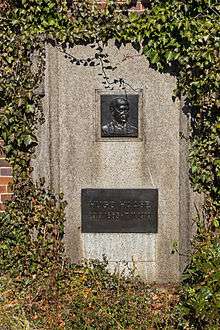Hugo Haase
| Hugo Haase | |
|---|---|
 Hugo Haase | |
| Reichstag | |
|
In office 1897–1907 | |
|
In office 1912–1919 | |
| Chairman of the Social Democratic Party of Germany | |
|
In office 1911–1916 | |
| Chairman of the Independent Social Democratic Party of Germany | |
|
In office 1917–1919 | |
| Personal details | |
| Born |
29 September 1863 Allenstein, East Prussia |
| Died |
7 November 1919 (aged 56) Berlin |
| Political party | SPD, USPD |
| Spouse(s) | Thea Lichtenstein |
| Children | Ernst Haase |
| Alma mater | Königsberg University |
| Occupation | lawyer |
Hugo Haase (29 September 1863 – 7 November 1919) was a German socialist politician, jurist and pacifist. With Friedrich Ebert, he co-chaired of the Council of the People's Deputies after the German Revolution of 1918–19.
Early life
Hugo Haase was born on 29 September 1863 in Allenstein (today: Olsztyn), in the Province of East Prussia, the son of Jewish shoemaker and small businessman, Nathan Haase, and his wife Pauline[1] (née Anker).
After attending the Gymnasium at Rastenburg,[2] Haase studied law in Königsberg (now Kaliningrad), joined the Social Democratic Party of Germany (SPD) in 1887 and the next year established himself as a lawyer. He was the first socialist lawyer in East Prussia and mainly took on as clients people from the lower classes (workers, peasants), journalists and socialist functionaries. In 1894, Haase became the first Social Democrat in the municipal parliament (Stadtverordnetenversammlung )of Königsberg. In 1897, he was elected to the Reichstag in a by-election.[3]
In multiple legal cases, he defended Social Democrats against various politically motivated charges. High-profile cases that made him known throughout the country included the so-called Königsberger Geheimbundprozeß in 1904, in which he achieved acquittals for several politicians including the later Minister President of Prussia, Otto Braun. In 1907, Haase was counsel for Karl Liebknecht (SPD) who had been charged with high treason for publishing his screed Militarismus und Antimilitarismus.[3]
Haase belonged to the so-called "revisionist" wing of the party, which in contrast to the Marxists, supported gradual reforms and no longer saw the best path to social and political change in revolution. In 1911, he became SPD chairman along with August Bebel, in 1912 Haase was reelected to the Reichstag and, together with Philipp Scheidemann, became chairman of the SPD Reichstag group. After Bebel's death in 1913, Haase and Friedrich Ebert were chosen as the party chairmen.[3] However, he remained active as a lawyer (now with an office in Berlin). By contrast with Ebert, Bebel and Scheidemann, Haase was not a home-grown party functionary but a radical intellectual.[1]
First World War, founding of the USPD
In July 1914, he organized the anti-World War I rallies of the SPD and on 31 July and 1 August fought for the SPD to vote in the Reichstag against an increase in war loans. However, he failed to accomplish this due to the opposition of Friedrich Ebert and the faction majority. In the decisive meeting of the SPD delegates on 3 August, only Haase and 13 others refused to support the loans. Bowing to party discipline, Haase then voted for the loans in the Reichstag and, as chairman, had to defend the SPD vote in the session of 4 August.[3][1] In response to his comment "We won't abandon the Fatherland in the hour of danger", the imperial government created its so-called Burgfrieden policy.
After the collapse of German war plans at the end of 1914, Haase became more and more vocal against the policies of the SPD faction. He was forced to resign as faction leader in 1915. That June, he signed the manifesto Gebot der Stunde which openly opposed the war aims of the government. In March 1916, Haase and 18 other SPD delegates voted against the government's emergency budget. He was forced to resign as party chairman of the SPD. He then founded and led the Sozialdemokratische Arbeitsgemeinschaft. In April 1917, Haase became chairman of the newly founded Independent Social Democratic Party of Germany (USPD), which split from the so-called "Majority Social Democrats" group and advocated immediate peace negotiations.[3][1]


German revolution, Council of the People's Deputies and 1919
In the course of the German Revolution in November 1918, along with the majority Social Democrats' leader Ebert, Haase became joint chairman of the provisional government, the Council of the People's Deputies. Haase thus distanced himself from those in the USPD who were seeking to establish a dictatorship of the proletariat through powerful soldiers' and workers' councils.[3]
After the Council led by Ebert ordered the bloody suppression of the revolutionary Volksmarinedivision during Christmas 1918, Haase and the two other USPD representatives Wilhelm Dittman and Emil Barth left the government on 29 December in protest.[3]
Even then, Haase supported continued cooperation with the SPD and was in favour of elections to the Weimar National Assembly—both views not universally popular in his party where many preferred a council-based republic.[1] After the founding of the Kommunistische Partei Deutschlands (KPD) in late 1918/early 1919, Haase argued in favour of a reunification between USPD and majority SPD.[3]
Notwithstanding this position, many in the majority SPD loathed him. This was mainly due to the fact that the USPD's very existence provided a political alternative to the left of the SPD, which was particularly attractive to many workers. In order to retain the support of the revolutionary masses, the SPD leadership thus was forced to steer a more leftist course than they would otherwise have chosen if left to their own devices. It also made their job of feeding the population, keeping up law and order and decommissioning the huge war-time army whilst replacing the Empire with a republic harder by threatening to antagonize the mostly conservative civil service and, in particular, the leadership of the military.[1]
The Haase-led USPD only achieved a disappointing 7% of the vote for the National Assembly on 19 January 1919.
On 8 October 1919, Haase was shot by Johann Voss, an apparently mentally ill leather worker. He was severely injured and died on 7 November.[3] Haase is buried on the Zentralfriedhof Friedrichsfelde in Berlin.
Hugo Haase had been married to Thea (née Lichtenstein) with whom he had a son.[1]
